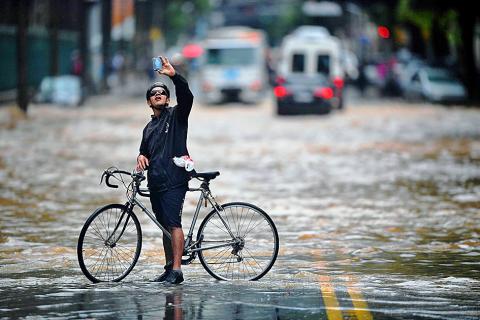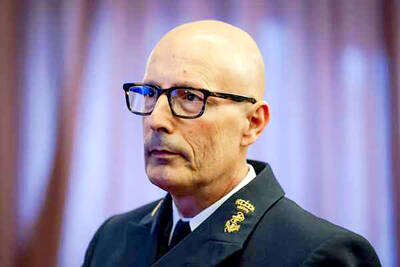Selfies, which have become a global sensation in the past decade or so, have remarkably killed five times more people than sharks.
The death toll has crept up incrementally each year as smartphones become more sophisticated and selfie sticks increase the range at which people can snap themselves, prompting them to take bigger risks for the perfect shot.
Between October 2011 and November 2017, at least 259 people died taking selfies around the globe, according to India’s Journal of Family Medicine and Primary Care, compared with just 50 people killed by sharks in the same period.

Photo: AFP
While women take the most selfies, young men, who are more prone to take risks, make up three-quarters of the selfie deaths — in drownings, crashes, falls or shooting accidents.
India, with a population of more than 1.3 billion and 800 million cellphones, holds the record for the number of people dying in the act of photographing themselves, with 159 recorded so far.
That is more than half of the global total — and a testament of sorts to the nation’s love of group photos and its youthful population.
India has seen selfie-snapping groups of youths die when they were hit by a train or drowning when their boat sank at the moment they were clicking the shutter. The situation has become so dire that India has set up “no selfie” zones — 16 of them in the city of Mumbai alone.
The country came in far ahead of Russia (16 deaths), the US (14) and Pakistan.
In Russia, people have fallen from bridges and high-rise buildings, shot themselves or even died while handling a land mine. Police issued a guide to “selfies without danger” in 2015.
In the US, most of those involved in selfie deaths fatally shot themselves while seeking the perfect pose. A number of people have fallen to their deaths at the Grand Canyon.
Rescue services in Croatia used Twitter to ask tourists to “stop taking stupid and dangerous selfies” after a Canadian miraculously survived a 75m fall in the Plitvice Lakes region.
In January, Taiwanese social media celebrity Gigi Wu (吳季芸) — known as the “bikini hiker” for taking selfies on top of mountain peaks dressed in a bikini — died when she fell into a ravine. She was 36.
Even when they are not fatal, selfies can be extremely macabre. In 2014, a Brazilian woman sparked rage online when she took a smiling selfie in front of the coffin of presidential candidate Eduardo Campos at his funeral.
Social media influencer Sueli Toledo also caused a stir online when she posted a picture on Instagram with the caption: “My look today for the funeral of a super friend.”
Selfies in places deemed sacred or hallowed — especially when they honor the dead — can also raise questions.
At the former Nazi death camp of Auschwitz in Poland, visited by 2.1 million people every year, museum staff do not hesitate to contact people who post selfies deemed to be inappropriate.
From Brazil to Vietnam and Germany, witnesses to traffic accidents have posted selfies at the scene of the crash.
More and more, selfies — even in tourist havens — are becoming a bit of a nuisance for locals.
Residents of the picturesque Rue Cremieux in Paris were so disturbed by the constant stream of selfie-snapping tourists outside their windows that they started their own Instagram account, clubcremieux, where they publish pictures of the most absurd posers outside their doors, skewering them with barbed captions.
The same thing happened in Hong Kong, where residents of the vast multi-colored Quarry Bay apartment complex put up signs banning photos.
Facing the mad frenzy of endless selfies, Vienna has launched a campaign for a digital detox.
The Belvedere Museum has put up a large copy of Gustav Klimt’s classic painting The Kiss near the original and added a giant red hashtag, so that visitors can take their selfie next to the facsimile and actually look at the real work of art.

ECONOMIC WORRIES: The ruling PAP faces voters amid concerns that the city-state faces the possibility of a recession and job losses amid Washington’s tariffs Singapore yesterday finalized contestants for its general election on Saturday next week, with the ruling People’s Action Party (PAP) fielding 32 new candidates in the biggest refresh of the party that has ruled the city-state since independence in 1965. The move follows a pledge by Singaporean Prime Minister Lawrence Wong (黃循財), who took office last year and assumed the PAP leadership, to “bring in new blood, new ideas and new energy” to steer the country of 6 million people. His latest shake-up beats that of predecessors Lee Hsien Loong (李顯龍) and Goh Chok Tong (吳作棟), who replaced 24 and 11 politicians respectively

Archeologists in Peru on Thursday said they found the 5,000-year-old remains of a noblewoman at the sacred city of Caral, revealing the important role played by women in the oldest center of civilization in the Americas. “What has been discovered corresponds to a woman who apparently had elevated status, an elite woman,” archeologist David Palomino said. The mummy was found in Aspero, a sacred site within the city of Caral that was a garbage dump for more than 30 years until becoming an archeological site in the 1990s. Palomino said the carefully preserved remains, dating to 3,000BC, contained skin, part of the

Russian hackers last year targeted a Dutch public facility in the first such an attack on the lowlands country’s infrastructure, its military intelligence services said on Monday. The Netherlands remained an “interesting target country” for Moscow due to its ongoing support for Ukraine, its Hague-based international organizations, high-tech industries and harbors such as Rotterdam, the Dutch Military Intelligence and Security Service (MIVD) said in its yearly report. Last year, the MIVD “saw a Russian hacker group carry out a cyberattack against the digital control system of a public facility in the Netherlands,” MIVD Director Vice Admiral Peter Reesink said in the 52-page

‘WATER WARFARE’: A Pakistani official called India’s suspension of a 65-year-old treaty on the sharing of waters from the Indus River ‘a cowardly, illegal move’ Pakistan yesterday canceled visas for Indian nationals, closed its airspace for all Indian-owned or operated airlines, and suspended all trade with India, including to and from any third country. The retaliatory measures follow India’s decision to suspend visas for Pakistani nationals in the aftermath of a deadly attack by shooters in Kashmir that killed 26 people, mostly tourists. The rare attack on civilians shocked and outraged India and prompted calls for action against their country’s archenemy, Pakistan. New Delhi did not publicly produce evidence connecting the attack to its neighbor, but said it had “cross-border” links to Pakistan. Pakistan denied any connection to